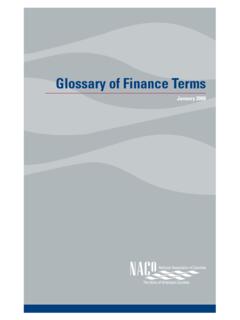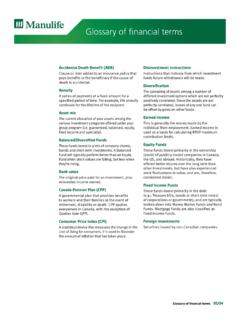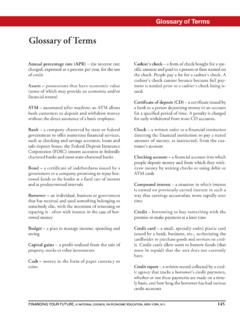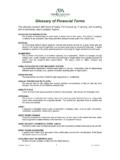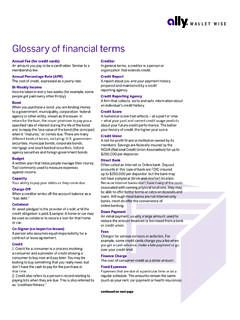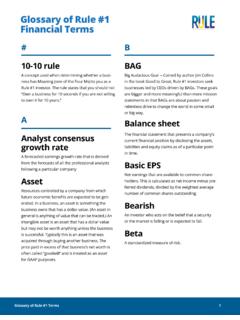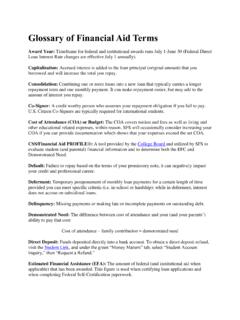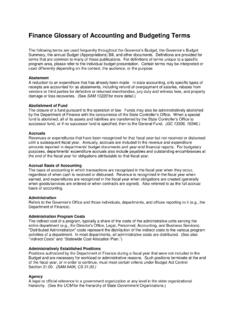Transcription of Glossary of Financial Terms - Peregrine Academics
1 Glossary of Terms A Abatement. A complete or partial cancelation of an expenditure or revenue. Abatement of expenditures. Cancelation of part or all of a charge previously made, usually because of refunds, rebates, resale of materials originally purchased by the local educational agency (LEA), or collections for loss or damage to the LEA's property. An abatement of expenditure applies to current expenditures and capital outlay expenditures from all funds. Abatement of revenue. The cancelation of all or some part of any specific revenue previously recorded. Account group. A self-balancing set of accounts that list government's fixed assets and long-term debt and that are not otherwise a part of governmental funds.
2 Accounting period. A period of time for which records are maintained and at the end of which Financial statements are prepared covering the period. Account numbers or letters. Numbers and/or letters that are assigned to the ordinary titles of accounts for classification of accounts and ease of reference. Accounts payable. Amounts due and owed to private persons, business firms, governmental units, or others for goods received and/or services rendered prior to the end of the fiscal year. Includes amounts billed but not paid. Does not include amounts due to other funds of the same LEA. Accounts receivable.
3 Amounts due and owed from private persons, business firms, governmental units, or others for goods received and/or services rendered prior to the end of the fiscal year. Includes amounts billed but not received. Does not include amounts due from other funds of the same LEA. Accrual basis. That method of accounting in which revenue is recorded when earned, even though it has not yet been collected, and in which expenses are recorded when the liabilities are incurred, even if they have not been paid yet. Accrued expenditures. Expenditures incurred during the current accounting period that are not paid until a subsequent accounting period.
4 Accrued revenue. Revenue earned during the current accounting period that is not collected until a subsequent accounting period. Accumulated depreciation. A contra-asset account used to report the accumulation of depreciation. (See also Depreciation.) Actuarial basis. A basis used in computing the amount of contributions to be made periodically to a fund so that the total contributions plus the compounded earnings thereon will equal the required payments to be made out of the fund. The factors taken into account in arriving at the amount include the length of time over which each collection or payment is to be made and the rate of return compounded on such amounts over its life.
5 Ad valorem tax. A tax based on a percentage of the value of goods or services. Agency fund. A fund consisting of resources received and held by an LEA as an agent for others. July 2005 Glossary -1 Glossary of Terms Allocation. Division or distribution in accordance with a predetermined plan. Allowable costs. Costs that meet the specific criteria of a granting agency. Allowance. A provision for valuing an asset at net, such as an allowance for bad debts. The allowance for bad debts would be deducted from accounts receivable to reflect the receivables that are likely to be collectable. Apportionment. Allocation of state or federal aid, district taxes, or other moneys among LEAs or other governmental units.
6 Apportionment notice. A document notifying LEAs when moneys were deposited with the county treasurer. Appraisal. An estimate of property value made by the use of systematic procedures based on physical inspection and inventory, engineering studies, and other economic factors. Appropriation. An authorization, granted by the governing board, to make expenditures and to incur obligations for special purposes. An appropriation is usually limited in purpose, amount, and the time period during which it may be expended. Appropriation ledger. A subsidiary ledger containing an account for each appropriation. Each account usually shows the amount originally appropriated in the budget, budget increases or decreases during the year, expenditures, encumbrances, unencumbered balances, and other related information.
7 Arbitrage. The profit earned ( , interest earnings in excess of interest costs) from the investments of the proceeds of lower-interest tax-exempt securities in higher yielding taxable securities. Assessed valuation. Value placed on personal and real property by a governmental unit for purposes of taxation. Assets. Resources that are held or owned by an LEA and that have monetary value. Audit. An examination of documents, records, and accounts for the purpose of (1) determining the propriety of transactions; (2) ascertaining whether all transactions are recorded properly; and (3) determining whether statements that are drawn from accounts reflect an accurate picture of Financial operations and Financial status for a given period of time.
8 Audit finding. A weakness in internal controls or an instance of noncompliance with applicable laws and regulations that is presented in the audit report. Audit program. A detailed outline of work to be done and the procedures to be followed during an audit. Available cash. Cash that is on hand or on deposit in a given fund and that is unencumbered and can be used for meeting current obligations. Average daily attendance (ADA). Total approved days of attendance in the LEA divided by the number of days the schools in the LEA are in session for at least the required minimum day. (Refer to Education Code Section 46300 and California Code of Regulations, Title 5, Education, sections 400 424.)
9 Glossary -2 July 2005 Glossary of Terms B Balance sheet. A statement that shows the assets, liabilities, and fund balance or fund deficit of an entity at a specific date and that is properly classified to exhibit the Financial condition of the entity as of that specific date. Basis of accounting. The time at which revenues, expenditures, transfers, and related liabilities and assets are recognized in the accounts and are reported in the Financial statements. Bond. A certificate containing a written promise to pay a specified sum of money, called the face value, at a fixed time in the future, called the date of maturity, and specifying interest at a fixed rate, usually payable periodically.
10 Bond discount. The excess of the face value of a bond over the price for which it is acquired or sold. (The price does not include accrued interest at the date of acquisition or sale.) Bonded debt. That portion of indebtedness represented by outstanding bonds. Bonded debt service. Expenditures for interest and redemption of bonds. Bond premium. The excess of the price at which a bond is acquired or sold over its face value. (The price does not include accrued interest at the date of acquisition or sale.) Bonds authorized and unissued. Legally authorized bonds that have not been sold and that may be sold without further authorization.
